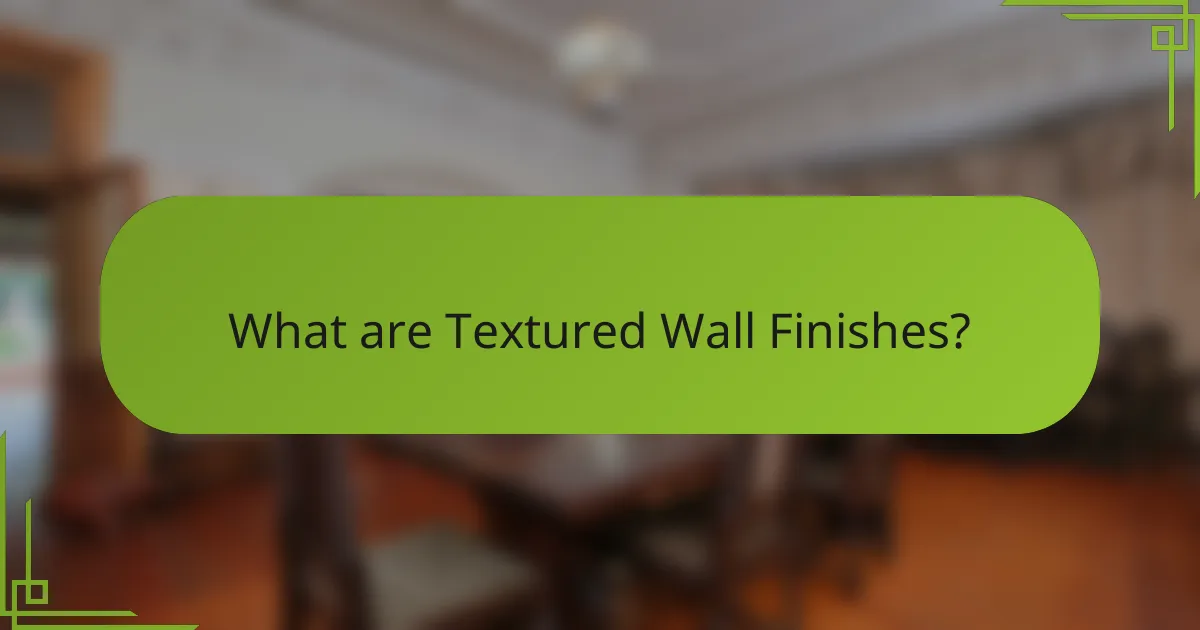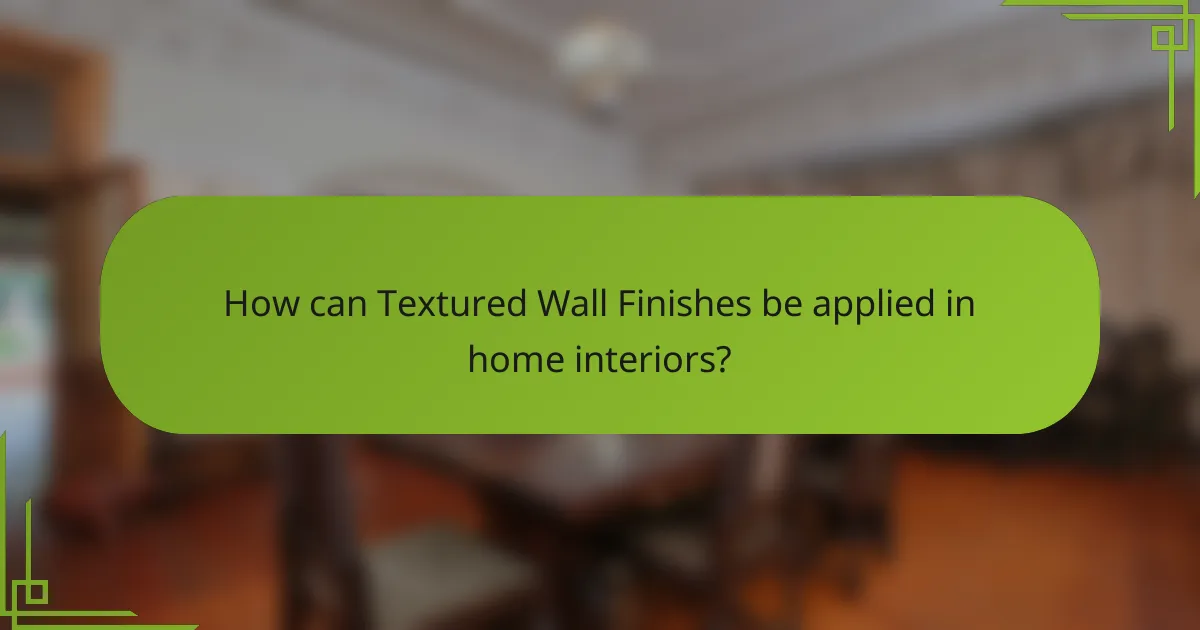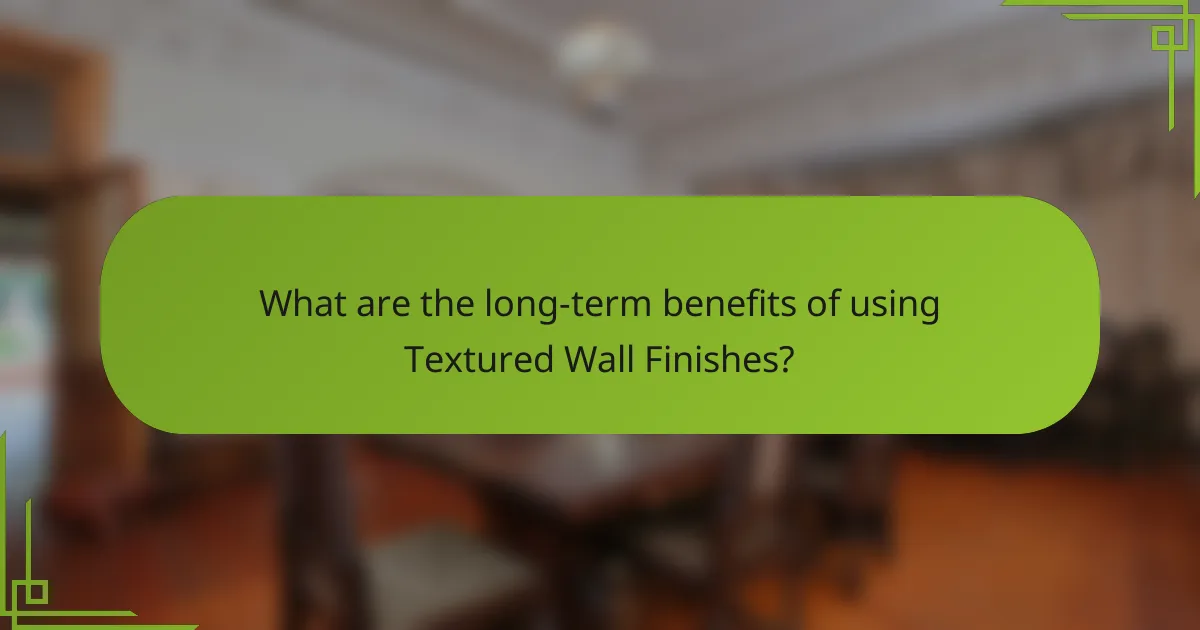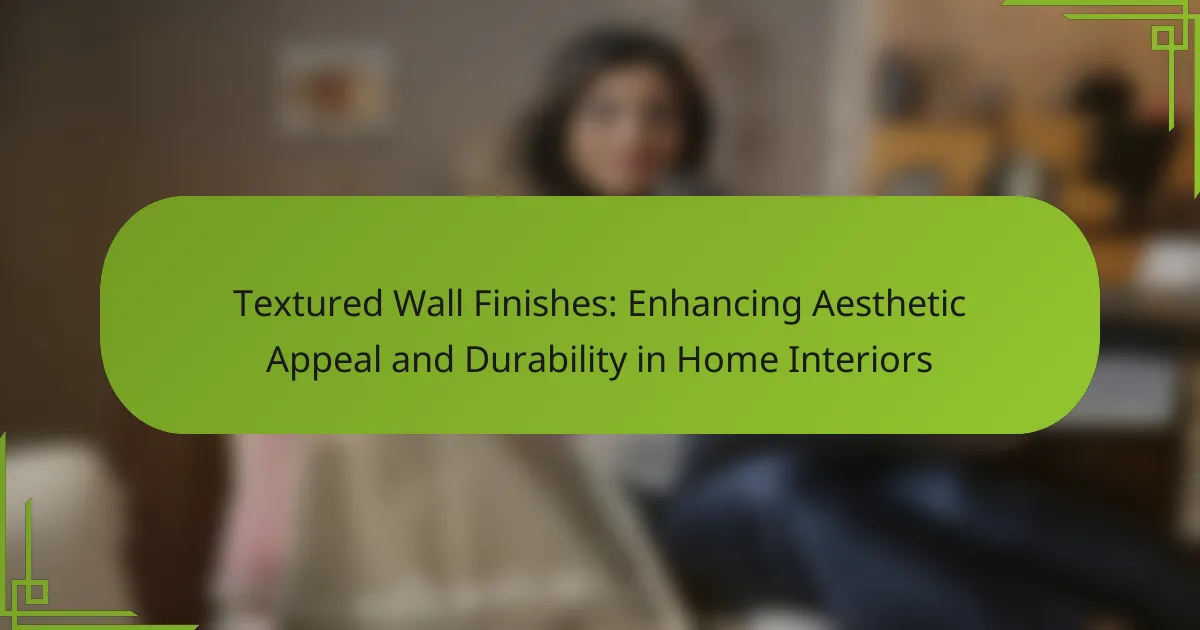
What are Textured Wall Finishes?
Textured wall finishes are decorative surface treatments applied to walls to create visual and tactile interest. These finishes can include techniques such as stucco, plaster, or paint additives that produce various patterns and textures. They enhance the aesthetic appeal of interior spaces by adding depth and dimension. Textured finishes can also improve durability, helping to conceal imperfections and resist wear. Common types include knockdown, skip trowel, and sand finish, each offering unique visual effects. These finishes are often used in residential and commercial settings to elevate design.
How do Textured Wall Finishes differ from traditional wall finishes?
Textured wall finishes differ from traditional wall finishes primarily in their surface appearance and tactile qualities. Textured finishes create three-dimensional patterns, enhancing visual interest. Traditional finishes typically offer a smooth, flat surface. Textured options can include techniques like stucco, plaster, or paint additives. These methods provide depth and complexity that traditional finishes lack. Additionally, textured finishes can help hide imperfections in walls better than smooth finishes. They also allow for greater customization in design and style. The use of textured finishes can contribute to improved acoustics and insulation in a space.
What are the various types of Textured Wall Finishes available?
The various types of textured wall finishes available include knockdown, stucco, and orange peel. Knockdown finish features a flat, mottled pattern created by spraying joint compound and then flattening it with a trowel. Stucco finish is a thicker, more pronounced texture often used for exterior walls, providing a rustic appearance. Orange peel finish resembles the skin of an orange, characterized by a subtle, bumpy texture that is achieved through spray application. Other types include slap brush, which creates a unique pattern using a brush technique, and popcorn finish, known for its heavy texture often used on ceilings. Each finish offers distinct aesthetic and durability benefits for home interiors.
What materials are commonly used in Textured Wall Finishes?
Common materials used in textured wall finishes include plaster, joint compound, and paint. Plaster is often applied for a durable and elegant finish. Joint compound offers versatility and ease of application. Paint can be mixed with additives to create various textures. Additionally, materials like wallpaper and fabric can also be utilized for unique effects. These materials enhance both aesthetic appeal and durability in home interiors.
Why are Textured Wall Finishes gaining popularity in home interiors?
Textured wall finishes are gaining popularity in home interiors due to their ability to enhance aesthetic appeal and provide durability. These finishes add depth and character to walls, making spaces feel more inviting. They can also help hide imperfections in wall surfaces, reducing the need for extensive repairs. Furthermore, textured finishes can improve acoustics by dampening sound, contributing to a more comfortable living environment. According to a survey by the National Association of Home Builders, 65% of homeowners prefer textured finishes for their unique visual impact. Additionally, these finishes are often easier to maintain than smooth surfaces, making them a practical choice for many homeowners.
What aesthetic benefits do Textured Wall Finishes provide?
Textured wall finishes enhance aesthetic appeal by adding depth and dimension to interiors. They create visual interest, making spaces feel more dynamic and inviting. Textured finishes can also complement various design styles, from rustic to modern. Additionally, they can mask imperfections on walls, providing a smoother overall appearance. The use of different materials and techniques allows for a wide range of textures, such as stucco, plaster, or fabric. This versatility enables homeowners to personalize their spaces effectively. Textured wall finishes can also reflect light differently, contributing to the ambiance of a room. Overall, these finishes transform ordinary walls into striking focal points.
How do Textured Wall Finishes enhance the durability of walls?
Textured wall finishes enhance the durability of walls by providing a protective layer that resists wear and tear. These finishes create a rough surface that can absorb impacts better than smooth surfaces. The texture helps to conceal minor imperfections and damage, prolonging the wall’s lifespan. Additionally, textured finishes can improve adhesion for paint and other coatings, reducing the frequency of maintenance. According to a study by the National Association of Home Builders, textured surfaces can withstand greater levels of moisture and are less prone to mold and mildew, contributing to overall durability.
What factors should be considered when choosing Textured Wall Finishes?
When choosing textured wall finishes, consider factors such as the desired aesthetic, durability, and maintenance requirements. The aesthetic should align with the overall design theme of the space. Durability is crucial for high-traffic areas, as some finishes resist wear better than others. Maintenance requirements vary; some textures may require regular cleaning or touch-ups. Additionally, the application method can influence the finish’s appearance and longevity. Environmental factors, like humidity and temperature, can also affect the choice of material. Finally, budget constraints will determine the range of options available.
How do different textures affect the overall design of a space?
Different textures significantly influence the overall design of a space. Textures can create visual interest and depth. For example, rough textures can evoke a rustic feel, while smooth textures may offer a modern aesthetic. Textured walls can also affect lighting; they can either absorb or reflect light. This interplay impacts the mood of the room. Additionally, varying textures can define areas within an open space. For instance, a textured wall can serve as a focal point. According to design principles, incorporating multiple textures adds complexity and richness to interiors. Thus, the choice of texture is crucial in shaping a space’s character and ambiance.
What maintenance requirements are associated with Textured Wall Finishes?
Textured wall finishes require regular cleaning and occasional touch-ups. Cleaning can be done with a soft brush or vacuum to remove dust and debris. For stains, a damp cloth with mild soap is effective. Touch-ups may involve repainting or reapplying texture material. Inspecting for damage periodically is essential. Repairing cracks or peeling promptly prevents further deterioration. Overall, maintaining these finishes ensures longevity and aesthetic appeal.

How can Textured Wall Finishes be applied in home interiors?
Textured wall finishes can be applied in home interiors through various techniques. These techniques include stucco, plaster, and paint additives. Stucco provides a durable and rustic appearance. It is typically applied in layers and can be customized in texture. Plaster finishes create a smooth or rough surface, depending on the application method. Paint additives can create texture without altering the underlying paint color.
These finishes enhance aesthetic appeal by adding depth and interest to walls. They can also improve durability by providing an extra layer of protection. Textured finishes can hide imperfections in the wall surface. They are suitable for both residential and commercial spaces, making them versatile. Overall, textured wall finishes are an effective way to elevate interior design.
What techniques are commonly used for applying Textured Wall Finishes?
Common techniques for applying textured wall finishes include knockdown, stucco, and sponge painting. Knockdown involves spraying joint compound on the wall and then flattening it with a trowel. This creates a unique, mottled texture. Stucco is a thicker material applied in layers, often used for a more rustic look. Sponge painting uses a sponge to apply paint, creating a soft, textured appearance. Other methods include trowel-on textures, where a trowel is used to create patterns, and brush techniques that involve brushing the surface to add depth. Each technique offers distinct visual effects and can enhance the durability of the wall finish.
What tools and equipment are necessary for application?
The necessary tools and equipment for applying textured wall finishes include a trowel, roller, and texture sprayer. A trowel is essential for spreading and smoothing the material. A roller helps in applying paint or primer evenly. A texture sprayer allows for more intricate patterns and designs. Additional tools may include drop cloths to protect floors, painter’s tape for clean edges, and sandpaper for surface preparation. Each tool serves a specific function to ensure a successful application. Proper use of these tools enhances the final appearance and durability of the textured finish.
How can DIY enthusiasts successfully apply Textured Wall Finishes?
DIY enthusiasts can successfully apply textured wall finishes by preparing the wall surface, selecting the right materials, and using proper application techniques. First, ensure the wall is clean, dry, and free of imperfections. This may involve patching holes and sanding rough areas. Next, choose a texture technique, such as sponge, brush, or spray. Each method produces a different look and requires specific tools. For instance, a sponge technique creates a soft, mottled effect while a brush technique can yield more defined patterns.
After selecting a method, mix the texture compound according to product instructions. Apply a base coat of paint if desired, allowing it to dry completely. Then, using the chosen technique, apply the textured finish evenly across the wall. Work in small sections for consistency. Lastly, allow the finish to cure as recommended by the manufacturer. Properly applied textured finishes can enhance both aesthetic appeal and durability of home interiors.
What are the common challenges in applying Textured Wall Finishes?
Common challenges in applying textured wall finishes include achieving uniformity and consistency in texture. Inconsistent application can lead to visible patches or uneven surfaces. Proper surface preparation is crucial; failure to clean or prime walls can affect adhesion. Additionally, selecting the right materials is essential; some textures may not adhere well to certain wall types. Weather conditions during application can also pose issues, as humidity and temperature affect drying times. Lastly, skill level of the applicator plays a significant role; inexperienced individuals may struggle with technique, resulting in subpar finishes.
How can issues like uneven texture be resolved?
To resolve issues like uneven texture on walls, sanding is an effective method. Sanding smooths out bumps and inconsistencies, creating a uniform surface. After sanding, applying a primer helps to prepare the wall for a fresh finish. Using a high-quality paint or texture spray can enhance the overall appearance. For larger areas, consider using a texture roller to achieve a consistent look. Additionally, patching any holes or dents before texturing is crucial for a seamless finish. Regular maintenance and touch-ups can prevent uneven texture from reappearing.
What safety precautions should be taken during application?
Wear appropriate personal protective equipment (PPE) during application. This includes gloves, goggles, and a mask. Ensure the work area is well-ventilated. Avoid inhaling fumes or dust from the materials used. Keep children and pets away from the application site. Follow manufacturer’s instructions for safe handling and application. Dispose of materials according to local regulations. Clean tools and surfaces immediately after use to prevent accidents. These precautions minimize health risks and enhance safety during the application of textured wall finishes.

What are the long-term benefits of using Textured Wall Finishes?
Textured wall finishes provide long-term benefits such as enhanced durability and aesthetic appeal. They resist wear and tear better than smooth surfaces. This longevity reduces the need for frequent repainting or repairs. Textured finishes can also hide imperfections in walls, maintaining a polished look over time. Additionally, they offer improved insulation properties, contributing to energy efficiency. Many textured finishes are also easier to clean, preserving their appearance. Studies show that textured walls can increase property value due to their visual interest and quality. Overall, these benefits make textured wall finishes a practical choice for homeowners.
How do Textured Wall Finishes contribute to home value?
Textured wall finishes enhance home value by improving aesthetic appeal and perceived quality. These finishes create visual interest and depth, making spaces feel more inviting. Homes with unique textures often stand out in the market. Potential buyers may view textured walls as a sign of higher craftsmanship. This perception can lead to increased offers during sales. Furthermore, textured finishes can hide imperfections in walls, reducing the need for repairs. According to a study by the National Association of Realtors, homes with updated interiors can sell for up to 10% more. Thus, textured wall finishes can significantly impact a home’s marketability and value.
What role do Textured Wall Finishes play in energy efficiency?
Textured wall finishes contribute to energy efficiency by improving insulation properties. These finishes create a layer of air pockets that enhance thermal resistance. As a result, they help maintain consistent indoor temperatures. This reduces the reliance on heating and cooling systems. Studies indicate that textured surfaces can lower energy consumption by up to 15%. Additionally, the aesthetic appeal of textured finishes can lead to longer-lasting materials, reducing the need for replacements. This longevity further supports energy efficiency by minimizing resource use over time.
How do Textured Wall Finishes affect indoor air quality?
Textured wall finishes can negatively impact indoor air quality. These finishes may trap dust, allergens, and pollutants in their uneven surfaces. Over time, this accumulation can lead to respiratory issues for occupants. Additionally, some textured finishes may contain volatile organic compounds (VOCs). VOCs can contribute to indoor air pollution and cause health problems. Proper maintenance and cleaning can mitigate these effects. Regular dusting and vacuuming can help reduce allergens. Selecting low-VOC or VOC-free materials can also improve air quality.
What tips can help in selecting and maintaining Textured Wall Finishes?
When selecting textured wall finishes, consider the room’s purpose and lighting. Choose finishes that complement the overall design style. Evaluate the durability and maintenance requirements of each finish. For maintenance, regularly dust and clean surfaces to prevent buildup. Use mild cleaning solutions to avoid damaging textures. Inspect for signs of wear and address issues promptly. Properly sealing textured finishes can enhance longevity. Always follow manufacturer guidelines for specific care instructions.
How can homeowners choose the right texture for their space?
Homeowners can choose the right texture for their space by considering the room’s function and style. Different textures create varying atmospheres. For example, smooth textures offer a modern feel, while rough textures add warmth. Homeowners should also assess the lighting in the space. Textures can reflect or absorb light, influencing the room’s ambiance. Additionally, the texture should complement existing decor. This ensures a cohesive look throughout the home. Finally, homeowners should consider maintenance requirements. Some textures may require more upkeep than others. By evaluating these factors, homeowners can select the most suitable texture for their interiors.
What are the best practices for cleaning and maintaining Textured Wall Finishes?
The best practices for cleaning and maintaining textured wall finishes include regular dusting and gentle cleaning. Use a soft-bristle brush or a microfiber cloth to remove dust and dirt. For stains, a mild detergent mixed with water can be applied with a sponge. Avoid abrasive cleaners that can damage the texture. Rinse the area with clean water after washing to prevent residue buildup. Inspect the wall regularly for signs of wear or damage. Repair any cracks or peeling promptly to maintain appearance and durability. These practices help preserve the aesthetic appeal and longevity of textured wall finishes.
Textured wall finishes are decorative treatments applied to walls that enhance both aesthetic appeal and durability. This article explores various types of textured finishes, including knockdown, stucco, and orange peel, detailing their unique attributes and the materials used for application. It also discusses the benefits of textured finishes, such as improved acoustics, durability, and energy efficiency, while addressing maintenance requirements and challenges during application. Additionally, the article provides guidance on selecting the right texture for different spaces and the long-term advantages these finishes offer in terms of home value and indoor air quality.
